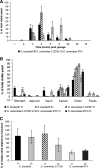Genotypic and physiological characterization of Saccharomyces boulardii, the probiotic strain of Saccharomyces cerevisiae
- PMID: 17293506
- PMCID: PMC1855594
- DOI: 10.1128/AEM.02201-06
Genotypic and physiological characterization of Saccharomyces boulardii, the probiotic strain of Saccharomyces cerevisiae
Abstract
Saccharomyces boulardii, a yeast that was isolated from fruit in Indochina, has been used as a remedy for diarrhea since 1950 and is now a commercially available treatment throughout Europe, Africa, and South America. Though initially classified as a separate species of Saccharomyces, recent publications have shown that the genome of S. boulardii is so similar to Saccharomyces cerevisiae that the two should be classified as conspecific. This raises the question of the distinguishing molecular and phenotypic characteristics present in S. boulardii that make it perform more effectively as a probiotic organism compared to other strains of S. cerevisiae. This investigation reports some of these distinguishing characteristics including enhanced ability for pseudohyphal switching upon nitrogen limitation and increased resistance to acidic pH. However, these differences did not correlate with increased adherence to epithelial cells or transit through mouse gut. Pertinent characteristics of the S. boulardii genome such as trisomy of chromosome IX, altered copy number of a number of individual genes, and sporulation deficiency have been revealed by comparative genome hybridization using oligonucleotide-based microarrays coupled with a rigorous statistical analysis. The contributions of the different genomic and phenotypic features of S. boulardii to its probiotic nature are discussed.
Figures





Similar articles
-
A Mutation in PGM2 Causing Inefficient Galactose Metabolism in the Probiotic Yeast Saccharomyces boulardii.Appl Environ Microbiol. 2018 May 1;84(10):e02858-17. doi: 10.1128/AEM.02858-17. Print 2018 May 15. Appl Environ Microbiol. 2018. PMID: 29523547 Free PMC article.
-
Molecular tools for differentiating probiotic and clinical strains of Saccharomyces cerevisiae.Int J Food Microbiol. 2005 Sep 15;103(3):295-304. doi: 10.1016/j.ijfoodmicro.2004.12.031. Int J Food Microbiol. 2005. PMID: 16099314
-
Molecular and physiological comparisons between Saccharomyces cerevisiae and Saccharomyces boulardii.Can J Microbiol. 2004 Aug;50(8):615-21. doi: 10.1139/w04-050. Can J Microbiol. 2004. PMID: 15467787
-
Yeasts as probiotics: Mechanisms, outcomes, and future potential.Fungal Genet Biol. 2020 Apr;137:103333. doi: 10.1016/j.fgb.2020.103333. Epub 2020 Jan 7. Fungal Genet Biol. 2020. PMID: 31923554 Review.
-
Saccharomyces boulardii: What Makes It Tick as Successful Probiotic?J Fungi (Basel). 2020 Jun 4;6(2):78. doi: 10.3390/jof6020078. J Fungi (Basel). 2020. PMID: 32512834 Free PMC article. Review.
Cited by
-
Effect of Process Parameters, Protectants and Carrier Materials on the Survival of Yeast Cells during Fluidized Bed Granulation for Tableting.Pharmaceutics. 2023 Mar 9;15(3):884. doi: 10.3390/pharmaceutics15030884. Pharmaceutics. 2023. PMID: 36986745 Free PMC article.
-
Probiotic and Potentially Probiotic Yeasts-Characteristics and Food Application.Foods. 2021 Jun 7;10(6):1306. doi: 10.3390/foods10061306. Foods. 2021. PMID: 34200217 Free PMC article. Review.
-
Systematic Engineering for Efficient Uric Acid-Degrading Activity in Probiotic Yeast Saccharomyces boulardii.ACS Synth Biol. 2025 Jun 20;14(6):2030-2043. doi: 10.1021/acssynbio.4c00831. Epub 2025 May 8. ACS Synth Biol. 2025. PMID: 40340401 Free PMC article.
-
Rare fungal infectious agents: a lurking enemy.F1000Res. 2017 Oct 31;6:1917. doi: 10.12688/f1000research.11124.1. eCollection 2017. F1000Res. 2017. PMID: 29152230 Free PMC article. Review.
-
Probiotics, prebiotics, and COVID-19 infection: A review article.Saudi J Biol Sci. 2021 Jan;28(1):865-869. doi: 10.1016/j.sjbs.2020.11.025. Epub 2020 Nov 9. Saudi J Biol Sci. 2021. PMID: 33424377 Free PMC article. Review.
References
-
- Adams, J., S. Puskas-Rozsa, J. Simlar, and C. M. Wilke. 1992. Adaptation and major chromosomal changes in populations of Saccharomyces cerevisiae. Curr. Genet. 22:13-19. - PubMed
-
- Bakalinsky, A. T., and R. Snow. 1990. The chromosomal constitution of wine strains of Saccharomyces cerevisiae. Yeast 6:367-382. - PubMed
-
- Bassetti, S., R. Frei, and W. Zimmerli. 1998. Fungemia with Saccharomyces cerevisiae after treatment with Saccharomyces boulardii. Am. J. Med. 105:71-72. - PubMed
-
- Berg, R., P. Bernasconi, D. Fowler, and M. Gautreaux. 1993. Inhibition of Candida albicans translocation from the gastrointestinal tract of mice by oral administration of Saccharomyces boulardii. J. Infect. Dis. 168:1314-1318. - PubMed
-
- Blanquet, S., S. Marol-Bonnin, E. Beyssac, D. Pompon, M. Renaud, and M. Alric. 2001. The “biodrug” concept: an innovative approach to therapy. Trends Biotechnol. 19:393-400. - PubMed
Publication types
MeSH terms
Substances
LinkOut - more resources
Full Text Sources
Other Literature Sources
Molecular Biology Databases

